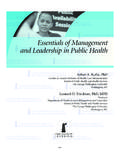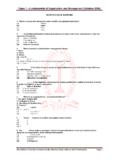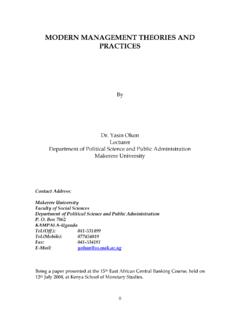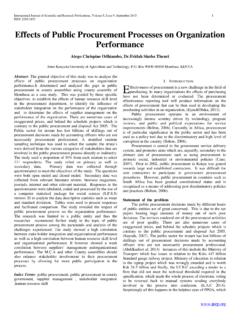Transcription of Introduction to Proactive Classroom Management
1 Chapter1 Introduction to Proactive Classroom ManagementKey TermsAccept-no-excuses mottoBehaviorism theoryBehavior modificationBiophysical theoryCan-do attitudeClassroom managementCommunityComplianceDeficit modelDevelopmental theoryDisciplineEmotional intelligenceGestaltInstructionMini theoriesModelsPositive behavioral supportsPreventionProactivePsychodynamic theoryReflectionRelational trustResponsible behaviorSchool achievementSocial competenceStructureTheoriesTurnaround teachers3 Chapter OutlineIntroductionThe Purpose of EducationProactive Classroom ManagementCan-Do AttitudeTurnaround TeachersAccept-No-Excuses MottoClassroom Management and AchievementSocial CompetenceSchool DisciplineReflectionEmotional RestraintPersonal NeedsMini TheoriesTheories and ModelsBiophysical TheoryPsychodynamic TheoryBehaviorism TheoryDevelopmental TheoryModelsAn Interactional PerspectiveStructure, Instruction, and DisciplineThe Beginning TeacherStructureInstructionDisciplineTex tbook OrganizationPart I: CommunityPart II: PreventionPart III.
2 Positive Behavioral SupportsWhat You Should KnowApplying the Concepts4 CHAPTER 1 Introduction to Proactive Classroom ManagementChapter ObjectivesAfter you finish reading this chapter you will be able to: Describe the relationship between Classroom Management and educational goals Explain the meaning and relevance of social competence Discuss how reflection improves teaching Explain how theories, mini theories, and models of human behavior influence teacher practice Compare and contrast biophysical, psychodynamic, behaviorist, and developmental theory Illustrate the Proactive Classroom Management pyramid Explain how structure, instruction.
3 And discipline support Proactive practices Outline the organization of this textIntroductionClassroom Management is the essential teaching skill. Teachers cannot teach and students cannotlearn in a Classroom plagued with disruptions. How Proactive teachers maintain control of theirclassrooms is the central theme of this text. Proactive Classroom Management is based on organizingthe Classroom in ways that create a positive physical and emotional environment. Proactive teachersestablish routines, lessons, and disciplinary strategies that teach students self-control. As studentstake more responsibility for their learning and behavior, teachers spend less time correcting misbe-havior.
4 Less attention to discipline concerns translates into more time for teaching and Management is the art and science of transforming a collection of youngpeople into a cohesive group of learners. Just as an artist combines paint, brush, and blank can-vas to create a memorable painting, a Classroom teacher crafts a learning environment from theraw tools of books, paper, and curriculum. While artists are noted for their style of painting,teachers express themselves through their style of Classroom Management . The Association forSupervision and Curriculum Development (ASCD) defines Classroom managementas a gestaltcombining several teacher traits, including reflection, skill in problem solving, skill in managingstudent behavior, and the ability to provide engaging instruction (Hansen & Childs, 1998).
5 A gestaltis a pattern or integrated structure that exceeds the sum of its parts. Coaches un-derstand the meaning of gestaltwhen they attempt to mold individual players into a champi-onship team. A gardener creates a gestalt by cultivating individual plants into a beautifullandscape. A poet selects individual words and composes verses; this, too, is a gestalt. Proactiveteachers structure Classroom interactions, routines, and activities so that all students, despitetheir strengths, weaknesses, and individual differences, become an integral part of a productiveclassroom text provides beginning educators with the tools they will need to create a learning en-vironment that is both productive and harmonious.
6 Although each teacher is alone in the class-room, his or her efforts are sustained by insights garnered by myriad education researchers. Theemphasis is on applied principles; however, application is worthwhile only when it is built onverified theory and principles of effective teaching. Throughout this text, the principles of class-room Management are embedded in a sturdy theoretical and empirical 1 Introduction to Proactive Classroom Management5 THEPURPOSE OFEDUCATIONHow a teacher approaches Classroom Management the priorities and techniques he or sheuses depends on his or her goals.
7 If the purpose of Classroom Management is to elicit compliance,the methods chosen will reflect this choice. For example, the military requires behavior rootedin obedience. The methods used to foster compliant behavior include intimidation, drills, routine,and loyalty oaths. These methods are appropriate because the military needs to train soldiers andsailors who will follow commands purpose of education is to teach students to be responsible citizens (Langdon, 1996).However, the word responsibleis an abstract term that has different meanings for different some, responsible behavior means obedience to authority.
8 To others, responsible behaviormeans exercising self-control, without the need for constant supervision. The definition ofresponsibilitythat guides the organization of this text is as follows: Responsible behavioris self-directed and is characterized by the ability to make socially appropriate choices, care for others,and be accountable for personal action. Figure illustrates the difference between complianceand responsibility. Marzano said the following about responsibility in the Classroom :Ample evidence indicates that teaching responsibility is a high priority in of self-discipline, Bear (1998) explains that the American public s belief that schoolsshould play a role in teaching self-discipline has never been greater than it is today (p.)
9 15). Hecites the 1996 Gallup study (Elam, Rose, & Gallup, 1996) indicating that 98 percent of thepublic believes that the primary purpose of public schools should be to prepare students to beresponsible citizens. (2003, p. 77)If educators want students to be responsible rather than compliant, they must think care-fully about how they can achieve their goal. The means used to manage students, the struc-tures developed, and the disciplinary techniques used must be considered in view of endresults (Charles, 2000). For instance, trying to teach students to make good choices whileSTOPC ompliancerequires behaviorrequires capacity to reflect on actions,to weigh choices, to make sensiblejudgments, and to act ofResponsibility6 CHAPTER 1 Introduction to Proactive Classroom Managementusing overbearing tactics to force obedience would be counterproductive (Good & Brophy,2000).
10 The teacher who extols virtues of student personal responsibility as he or she controlsstudents through rewards and punishments is preaching one set of values and exercising an-other. Kohn (2002) argued that teachers who try to have it both ways send mixed messagesthat undercut the value of each. To teach responsible behavior teachers should structure classroompractices that invite participation and use disciplinary approaches that promote teachers do not avoid problems in learning or problems with behavior. These teach-ers accept responsibility for their students successes and their students failures (Brophy,1983).
















